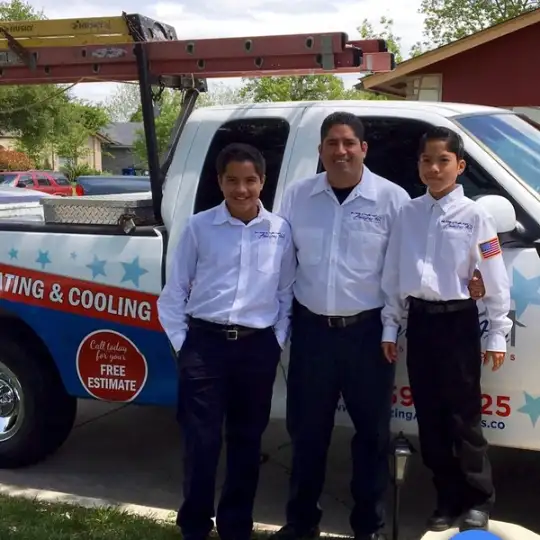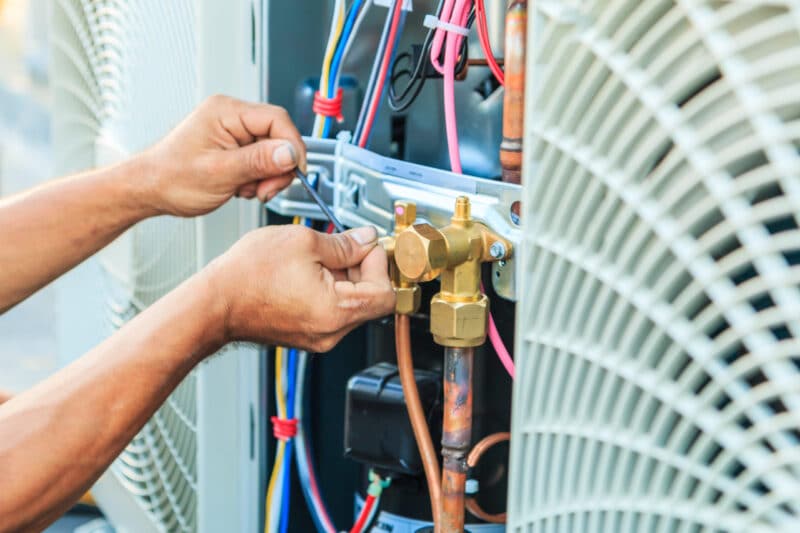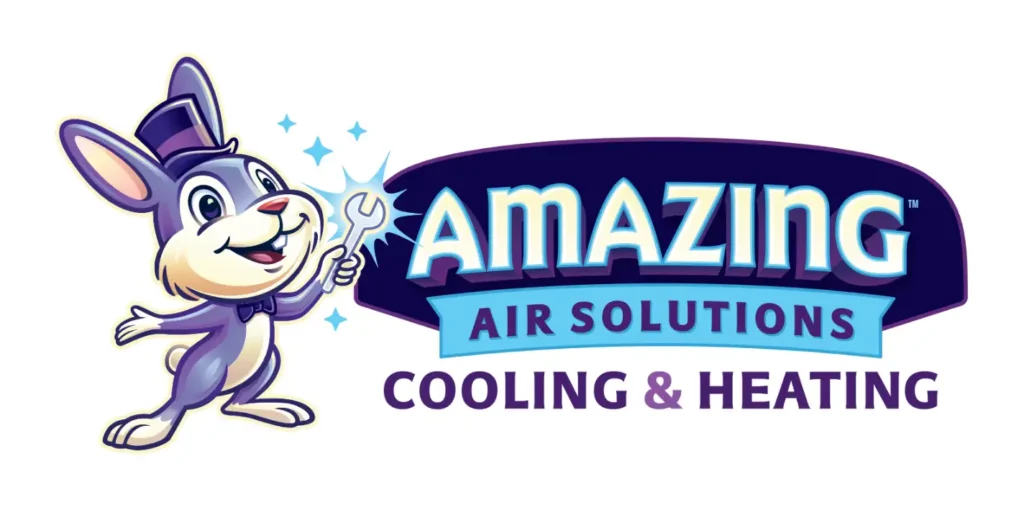
Need a reliable San Antonio AC and heating company to handle your cooling and heating needs? Reach out Amazing Air Solutions’s skilled team today and see why we’re one of the most trusted names in the area for exceptional service!
What you get from Amazing Air Solutions:
Don't wait until your A/C goes out on a hot summer day! Call us today to schedule your maintenance appointment
Providing routine maintenance on your cooling unit is essential for keeping your system running efficiently, extending its lifespan, and ensuring your home stays cool and comfortable. It’s a proactive measure that can save you money, improve indoor air quality, and reduce the likelihood of unexpected breakdowns.
Getting regular maintenance for your air conditioning (A/C) system is important for several reasons including:
Regular maintenance helps ensure that your A/C system operates at its peak efficiency. When your A/C is running efficiently, it consumes less energy, which can lead to lower utility bills.
Air conditioning maintenance can prolong the life of your system. When your A/C is well-maintained, it’s less likely to experience major breakdowns or failures, which can save you money on costly repairs or premature replacements.
Routine maintenance helps keep your cooling system’s components clean and in good working condition. This ensures that your A/C can effectively cool your home, providing consistent comfort throughout the hot summer months.
A well-maintained A/C system can help improve indoor air quality by removing dust, pollen, and other allergens from the air. Clean filters and coils prevent these particles from being circulated throughout your home.
Regular maintenance can catch minor issues before they escalate into major problems. This can save you money on unexpected and costly A/C repairs.
Maintenance appointments often involve inspections to identify potential issues early. Technicians can recommend necessary repairs or adjustments to prevent breakdowns during the peak cooling season.
Some A/C manufacturers require regular maintenance to keep your warranty valid. Skipping maintenance may void your warranty, leaving you responsible for any repair or replacement costs.
A well-maintained cooling unit operates quietly and reliably, providing you with consistent comfort and peace of mind.
Central AC systems provide consistent cooling throughout your home, eliminating hot spots or uneven cooling that can occur with window units.
An efficient A/C system consumes less energy, which reduces your carbon footprint and helps protect the environment.
While A/C maintenance does come with a cost, the potential savings in energy bills, repairs, and replacements over time can outweigh the initial investment.

No matter the situation, our Hollywood Park, TX professional HVAC technicians will work to determine the best plan of action for installing a new air conditioning system in your home or business. From there, we will review the recommendations with you in detail, so you will know exactly what solution is best for your cooling needs before any work is done.
Amazing Air Solutions offers a full line of installation, maintenance, and repair that your cooling system may require. You can count on our trusted professionals for exceptional service and quality craftsmanship. Amazing Air Solutions is proudly and professionally serving the greater Hollywood Park, TX area.

Air conditioning system maintenance is essential to ensure your unit operates efficiently, extends its lifespan, maintains indoor air quality, and reduces energy consumption.
It’s recommended to have your cooling system serviced at least once a year, preferably in the spring before the cooling season begins.
While there are some maintenance tasks you can do, like changing the air filter, it’s generally advisable to have a professional technician perform a comprehensive maintenance check to avoid potential problems and to ensure peace of mind.
A/C maintenance typically includes cleaning the coils, checking refrigerant levels, inspecting electrical components, lubricating moving parts, tightening connections, and calibrating thermostats.
Common signs include reduced cooling efficiency, strange noises, unusual odors, frequent cycling, and increased energy bills.
You can improve A/C efficiency by keeping your system’s air filter clean, sealing duct leaks, maintaining proper insulation, and using a programmable thermostat.
Call Us Today! (210) 538-7228

Air conditioning systems are essential for maintaining a comfortable indoor environment, especially during hot summer months. However, like any home appliance, these units have a lifespan and may need to be replaced when they no longer function efficiently or reliably. Here are five critical warning signs that indicate your air conditioner might require immediate replacement.
If you find yourself calling an HVAC technician repeatedly to fix your air conditioning unit, it may be time to evaluate whether replacing the system is more cost-effective.
An air conditioner nearing the end of its life often struggles to maintain consistent indoor temperatures.
Replacing an underperforming unit with a modern, energy-efficient model can significantly improve comfort and reduce energy bills.
Older AC systems tend to lose efficiency over time due to wear and tear on critical components such as compressors or evaporator coils. If you notice your electricity bills climbing despite consistent usage patterns, it could be due to an inefficient air conditioner consuming excessive energy.
SEER Rating* | Estimated Annual Energy Cost** |
13 SEER | $400 |
16 SEER | $320 |
20 SEER | $260 |
SEER (Seasonal Energy Efficiency Ratio): Higher ratings indicate better efficiency.
*Calculated for typical household usage; actual costs may vary.
Upgrading to a system with a higher SEER rating can lead to substantial long-term savings.
While some minor issues might be repairable, persistent or severe problems typically justify replacing the entire system.
Most air conditioners last between 10 and 15 years, depending on usage and maintenance habits. If your unit is approaching or exceeding this lifespan, it likely operates less efficiently than newer models equipped with advanced technology like smart thermostats and variable-speed compressors.
By recognizing these warning signs early, homeowners can avoid the inconvenience of unexpected breakdowns during peak seasons while maximizing comfort and long-term savings through proactive replacement decisions.
Replacing an HVAC system is a significant investment and requires careful planning to ensure efficient upgrades. Whether you’re upgrading to improve energy efficiency, reduce repair costs, or address comfort issues, having a detailed checklist can help ensure the process goes smoothly. Below is a comprehensive checklist to guide you through every step of the HVAC replacement process.
Before replacing your HVAC system, evaluate the performance of your existing unit. This will help you identify specific areas that need improvement.
Every home has unique requirements when it comes to heating and cooling. Assessing these needs will help you choose the right system.
Key Factors | Description |
Home Size | Larger homes generally require systems with higher capacity. |
Insulation Quality | Well-insulated homes retain temperature better, reducing energy demands. |
Climate Zone | The local climate influences whether you need a system better suited for heating, cooling, or both. |
Energy-efficient systems not only reduce utility bills but also minimize environmental impact.
HVAC replacements can be costly, so it’s essential to determine your budget early in the process.
Selecting a qualified professional ensures proper installation and long-term reliability of your new system.
By following this checklist step by step, homeowners can ensure their HVAC replacement delivers maximum efficiency and comfort while staying within budgetary constraints.
When it comes to replacing your HVAC system, proper planning and execution are essential. An outdated or inefficient system not only impacts comfort but also leads to higher energy bills and potential safety concerns. Below is a comprehensive checklist to guide you through the HVAC replacement process, ensuring an efficient upgrade that meets your needs.
Before moving forward with a replacement, assess the condition of your existing HVAC system.
– Frequent Repairs: If repair costs are adding up, it may be more cost-effective to replace the unit.Inconsistent Temperatures: Uneven cooling or heating between rooms suggests inefficiency.Age of Equipment: Most HVAC systems have a lifespan of 10-15 years; older units may struggle to perform efficiently.Rising Energy Bills: Older systems tend to consume more energy due to wear and outdated technology.
Make sure the replacement system matches your household’s specific requirements: – Calculate the square footage of your home for accurate sizing. – Consider insulation levels, window quality, and climate conditions. – Address any issues with airflow or ventilation in certain parts of the house.
A professional load calculation, such as one based on Manual J standards, can provide precise recommendations tailored to your home.
Modern HVAC systems offer advanced features that improve efficiency while reducing energy consumption: | Feature | Benefit | |———————————-|———————————————–| | SEER Rating (Seasonal Energy Efficiency Ratio)| Higher ratings indicate better cooling efficiency.Variable-Speed Motors| Adjust speed based on demand, reducing energy waste.Smart Thermostats Compatibility| Optimize temperature settings remotely via smartphone apps.
Look for units carrying ENERGY STAR certification as they meet strict efficiency guidelines set by the U. S. Environmental Protection Agency.
Determine how much you’re prepared to spend on a new HVAC system while factoring in additional costs such as installation labor and potential ductwork modifications: – Request multiple quotes from reputable contractors. – Check if local utility companies offer rebates or incentives for upgrading to energy-efficient models. – Explore financing options like payment plans offered by retailers or contractors.
Hiring an experienced contractor is critical for proper installation: – Verify licensing and certifications (e. g. , NATE-certified technicians). – Read online reviews and request references from past clients. – Ensure they perform a detailed inspection before providing recommendations.
A knowledgeable contractor will also advise on warranties included with your new system.
To protect your investment and maintain optimal performance: – Schedule annual tune-ups with an HVAC professional to clean coils, check refrigerant levels, and inspect components. – Replace air filters every 1–3 months depending on usage and filter type.
Regular maintenance ensures longevity while keeping energy consumption low.
By following this checklist step by step, you’ll ensure that your new HVAC system meets both comfort needs and long-term efficiency goals without compromising quality or budget considerations.
Below are some practical repair tips to help you enhance the performance of your AC unit.
– Check the air filter every 1-2 months during peak summer usage.
– If the filter is dirty, clean it (for washable filters) or replace it with a new one.
– Use high-quality filters that match the specifications of your AC manufacturer.
Replacing filters regularly not only improves cooling but also extends the life of your system.
Over time, dirt and debris can accumulate on the condenser coils, reducing their ability to release heat effectively.
1. Turn off power to your AC unit before cleaning. 2. Remove any debris like leaves or grass clippings around and within the outdoor coil housing. 3. Use a coil cleaner spray designed for air conditioners and gently rinse with water.
Improper thermostat settings can impact performance significantly.
– Verify that the thermostat is set to “Cool” mode and adjust the temperature according to your comfort level (typically between 72°F – 76°F).
– If you have a programmable or smart thermostat, ensure schedules align with when you’re at home versus away.
Upgrading to a smart thermostat can improve energy efficiency while maintaining effective cooling levels.
Air leaks in windows, doors, and ductwork force your AC system to work harder than necessary.
– Inspecting windows and doors for gaps; use weatherstripping materials where necessary. – Checking ductwork for visible damage or leaks; seal them with aluminum tape or mastic sealant. – Ensuring proper insulation in attics and walls helps maintain cool indoor temperatures more efficiently.
By sealing air leaks, you reduce energy waste while boosting overall comfort.
Low refrigerant levels reduce cooling effectiveness but should only be addressed by licensed HVAC professionals due to safety concerns.
– Warm air blowing from vents instead of cold. – Ice buildup on refrigerant lines or evaporator coils.
If these symptoms are present, call an HVAC technician promptly for accurate diagnosis and repair.
Blocked vents disrupt airflow distribution throughout your home.
1. Ensure vents are fully open in all rooms for balanced airflow. 2. Move furniture or objects that block vent openings. 3. Vacuum dust buildup from vent grilles periodically.
This simple step boosts circulation while preventing uneven temperature zones in your living space.
By incorporating these practical tips into regular maintenance routines, homeowners can enhance their air conditioner’s performance significantly while minimizing costly repairs over time.
Air conditioner problems can arise unexpectedly, leaving your home uncomfortable and your energy bills skyrocketing. While some issues require professional intervention, many common AC problems can be handled effectively with a bit of troubleshooting and regular maintenance. Below is a guide to diagnosing and addressing routine air conditioner problems without calling in an expert.
Problem Area | Solution | Frequency |
Thermostat | Verify settings | As needed |
Air Filters | Clean or replace | Monthly/Quarterly |
Vents & Registers | Clear obstructions | Regularly |
Quick Tip:Use a solution of vinegar and water monthly in your drain line to prevent clogs.
Month | Energy Bill Before Maintenance ($) | Energy Bill After Maintenance ($) |
June | $200 | $160 |
July | $230 | $180 |
By following these diagnostic steps and implementing simple solutions, you can tackle many common air conditioning issues yourself while maintaining peak performance throughout its lifespan.
Proper maintenance and timely troubleshooting of HVAC systems can help extend their lifespan and ensure they operate efficiently. While some issues require professional attention, many common furnace and AC problems can be addressed with DIY solutions. Below is a guide to help you troubleshoot your HVAC system effectively while staying safe.
Furnaces are essential for keeping your home warm during colder months.
Your air conditioner plays a key role in regulating indoor temperatures during warmer months.
Tool | Purpose |
Screwdrivers | To access panels or secure components |
Multimeter | For testing electrical connections |
Shop Vacuum | To clean drainage lines |
Soft Brush | For cleaning coils without causing damage |
Flashlight | To inspect tight spaces |
DIY solutions are effective tools in maintaining HVAC systems but knowing when to call an expert safeguards both safety and equipment longevity. A proactive approach contributes significantly toward ensuring consistent comfort levels at home year-round.
Copyright © 2025 Amazing Air Solutions. Camp Digital – All Rights Reserved. Privacy Policy.